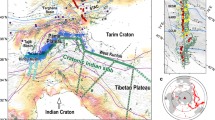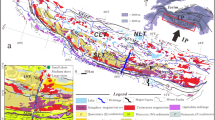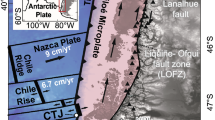Abstract
The fate of the Indian plate during continental collision with Asian terranes, and the proportion of the Indian crust that is underthrust or subducted beneath Tibet as opposed to transferred to the upper (Himalayan) plate, are much debated. The active geometry of low-angle underthrusting or subduction of the Indian plate beneath the Lesser and Greater Himalayan thrust sheets is well known from seismic imaging. Previously, only lower-resolution images of the Main Himalayan Thrust have been obtained beneath the Yarlung Zangbo suture that separates Indian and Asian rocks at the surface. It remains controversial whether the orogenic wedge between the Main Himalayan Thrust and the Yarlung Zangbo suture, formed of Indian crust transferred to the upper plate, is evolving by thrust-faulting in a critical-taper wedge or by southward extrusion of a ductile channel flow. Here we present a seismic reflection profile across the western Himalaya at 81.5° E, and show that the Main Himalayan Thrust dips ∼20° to ∼60 km depth beneath the Yarlung Zangbo suture, approaching a continuous Moho reflection at ∼70–75 km depth. The Indian crust being transported northwards beyond the Yarlung Zangbo suture is no more than ∼15 km thick, reduced from its original ∼40 km thickness by transfer of material from the lower plate to the upper plate through crustal-scale duplexing.
This is a preview of subscription content, access via your institution
Access options
Subscribe to this journal
Receive 12 print issues and online access
$259.00 per year
only $21.58 per issue
Buy this article
- Purchase on Springer Link
- Instant access to full article PDF
Prices may be subject to local taxes which are calculated during checkout



Similar content being viewed by others
Change history
17 June 2016
In the version of the Article originally published, in the Acknowledgements section the first National Natural Science Foundation of China grant number should have been 41574091. This has been corrected in all versions of the Article.
References
Leech, M. L., Singh, S., Jain, A., Klemperer, S. L. & Manickavasagam, R. The onset of India–Asia continental collision: early, steep subduction required by the timing of UHP metamorphism in the western Himalaya. Earth Planet. Sci. Lett. 234, 83–97 (2005).
Willett, S. D. & Beaumont, C. Subduction of Asian lithospheric mantle beneath Tibet inferred from models of continental collision. Nature 369, 642–645 (1994).
Nelson, K. D. et al. Partially molten middle crust beneath southern Tibet; synthesis of Project INDEPTH results. Science 274, 1684–1688 (1996).
Gao, R., Cheng, X. & Wu, G. Lithospheric structure and geodynamic model of the Golmud-Ejin transect in the northern Tibet. Geol. Soc. Am. Spec. Pap. 328, 9–17 (1999).
Ye, Z. et al. Seismic evidence for the North China plate underthrusting beneath northeastern Tibet and its implications for plateau growth. Earth Planet. Sci. Lett. 426, 109–117 (2015).
Klemperer, S. L. Crustal flow in Tibet: geophysical evidence for the physical state of Tibetan lithosphere, and inferred patterns of active flow. Geol. Soc. Lond. Spec. Publ. 268, 39–70 (2006).
Capitanio, F. A., Morra, G., Goes, S., Weinberg, R. F. & Moresi, L. India–Asia convergence driven by the subduction of the Greater Indian continent. Nature Geosci. 3, 136–139 (2010).
Le Pichon, X., Fournier, M. & Jolivet, L. Kinematics, topography, shortening, and extrusion in the India-Eurasia collision. Tectonics 11, 1085–1098 (1992).
Sapin, M. & Hirn, A. Seismic structure and evidence for eclogitization during the Himalayan convergence. Tectonophysics 273, 1–16 (1997).
Beaumont, C., Jamieson, R. A., Nguyen, M. H. & Lee, B. Himalayan tectonics explained by extrusion of a low-viscosity crustal channel coupled to focused surface denudation. Nature 414, 738–742 (2001).
Avouac, J. P. Mountain building: from earthquakes to geological deformation. Dynamic processes in extensional and compressional settings. Treatise Geophys. 6, 377–439 (2007).
Herman, F. et al. Exhumation, crustal deformation, and thermal structure of the Nepal Himalaya derived from inversion of thermochronological and thermobarometric data and modeling of the topography. J. Geophys. Res. 115, B06407 (2010).
Kohn, M. J. Himalayan metamorphism and its tectonic implications. Annu. Rev. Earth Planet. Sci. 42, 381–419 (2014).
Wu, G., Xiao, X., Li, T., Liu, X. & Gao, R. China Global Geoscience Transect No. 3 32 (Inter-Union Commission on the Lithosphere and American Geophysical Union, 1991).
Makovsky, Y., Klemperer, S. L., Ratschbacher, L. & Alsdorf, D. Midcrustal reflector on INDEPTH wide-angle profiles: an ophiolitic slab beneath the India-Asia suture in southern Tibet? Tectonics 18, 793–808 (1999).
Zhao, W., Nelson, K. D. & Project INDEPTH Team. Deep seismic reflection evidence for continental underthrusting beneath southern Tibet. Nature 366, 557–559 (1993).
Alsdorf, D. et al. Crustal deformation of the Lhasa terrane, Tibet Plateau from Project INDEPTH deep seismic reflection profiles. Tectonics 17, 501–519 (1998).
Rajendra Prasad, B., Klemperer, S. L., Rao, V. V., Tewari, H. & Khare, P. Crustal structure beneath the Sub-Himalayan fold-thrust belt, Kangra recess, northwest India, from seismic reflection profiling: implications for Late Paleoproterozoic orogenesis and modern earthquake hazard. Earth Planet. Sci. Lett. 308, 218–228 (2011).
Caldwell, W. B., Klemperer, S. L., Lawrence, J. F., Rai, S. S. & Ashish Characterizing the Main Himalayan Thrust in the Garhwal Himalaya, India with receiver function CCP stacking. Earth Planet. Sci. Lett. 367, 15–27 (2013).
Nabelek, J. et al. Underplating in the Himalaya–Tibet collision zone revealed by the Hi-CLIMB experiment. Science 325, 1371–1374 (2009).
Schulte-Pelkum, V. et al. Imaging the Indian subcontinent beneath the Himalaya. Nature 435, 1222–1225 (2005).
Kind, R. et al. Seismic images of crust and upper mantle beneath Tibet: evidence for Eurasian plate subduction. Science 298, 1219–1221 (2002).
Shi, D. et al. Receiver function imaging of crustal suture, steep subduction, and mantle wedge in the eastern India–Tibet continental collision zone. Earth Planet. Sci. Lett. 414, 6–15 (2015).
Klemperer, S. L. et al. Mantle fluids in the Karakoram fault: helium isotope evidence. Earth Planet. Sci. Lett. 366, 59–70 (2013).
Murphy, M. A. et al. Structural evolution of the Gurla Mandhata Detachment system, southwest Tibet: implications for the eastward extent of the Karakoram fault system. Geol. Soc. Am. Bull. 114, 428–447 (2002).
Murphy, M. A. & Yin, A. Structural evolution and sequence of thrusting in the Tethyan fold-thrust belt and Indus-Yalu suture zone, southwest Tibet. Geol. Soc. Am. Bull. 115, 21–34 (2003).
Murphy, M. A. et al. Limit of strain partitioning in the Himalaya marked by large earthquakes in western Nepal. Nature Geosci. 7, 38–42 (2014).
Gilligan, A., Priestley, K. F., Roecker, S. W., Levin, V. & Rai, S. S. The crustal structure of the western Himalayas and Tibet. J. Geophys. Res. 20, 3946–3964 (2015).
Razi, A. S., Levin, V., Roecker, S. W. & Huang, G. C. D. Crustal and uppermost mantle structure beneath western Tibet using seismic traveltime tomography. Geochem. Geophys. Geosyst. 15, 434–452 (2014).
Le Roux-Mallouf, R. et al. Evidence for a wide and gently dipping Main Himalayan Thrust in western Bhutan. Geophys. Res. Lett. 42, 3257–3265 (2015).
Lynn, H. B. & Deregowski, S. Dip limitations on migrated sections as a function of line length and recording time. Geophysics 46, 1392–1397 (1981).
Bollinger, L., Henry, P. & Avouac, J. Mountain building in the Nepal Himalaya: thermal and kinematic model. Earth Planet. Sci. Lett. 244, 58–71 (2006).
Klemperer, S. L., Hauge, T. A., Hauser, E. C., Oliver, J. E. & Potter, C. J. The Moho in the northern Basin and Range Province, Nevada, along the COCORP 40° seismic reflection transect. Geol. Soc. Am. Bull. 97, 603–618 (1986).
Chung, S.-L. et al. Adakites from continental collision zones: melting of thickened lower crust beneath southern Tibet. Geology 31, 1021–1024 (2003).
Miller, C., Schuster, R., Klötzli, U., Frank, W. & Purtscheller, F. Post-collisional potassic and ultrapotassic magmatism in SW Tibet: geochemical and Sr–Nd–Pb–O isotopic constraints for mantle source characteristics and petrogenesis. J. Petrol. 40, 1399–1424 (1999).
Pullen, A., Kapp, P., DeCelles, P. G., Gehrels, G. E. & Ding, L. Cenozoic anatexis and exhumation of Tethyan sequence rocks in the Xiao Gurla Range, southwest Tibet. Tectonophysics 501, 28–40 (2011).
Wobus, C., Heimsath, A., Whipple, K. & Hodges, K. Active out-of-sequence thrust faulting in the central Nepalese Himalaya. Nature 434, 1008–1011 (2005).
Acknowledgements
This study was financially supported by the Ministry of Land and Resources of China through SinoProbe (SinoProbe-02-01), by the National Natural Science Foundation of China (41574091, 41590863 and 41430213), and by the National Key Research and Development Project ‘Deep structure and mineralization process of the collisional orogenic metallogenic system in Tibet’. We thank the Fifth Geophysical Prospecting Company of Southwest Petroleum Bureau and Beijing Petrosound Geoservice, Ltd, for their part in acquiring and processing the seismic data.
Author information
Authors and Affiliations
Contributions
R.G., Z.L. and S.L.K. conceived this study, and R.G. and S.D. managed the project. Z.L., H.W., W.L. and H.L. supervised data acquisition and data processing. S.L.K. wrote the first draft of the paper, following discussion with, and contributions from, all authors. S.L.K. designed and drafted the figures.
Corresponding authors
Ethics declarations
Competing interests
The authors declare no competing financial interests.
Supplementary information
Supplementary Information
Supplementary Information (PDF 1627 kb)
Rights and permissions
About this article
Cite this article
Gao, R., Lu, Z., Klemperer, S. et al. Crustal-scale duplexing beneath the Yarlung Zangbo suture in the western Himalaya. Nature Geosci 9, 555–560 (2016). https://doi.org/10.1038/ngeo2730
Received:
Accepted:
Published:
Issue Date:
DOI: https://doi.org/10.1038/ngeo2730
This article is cited by
-
Coupled Surface Process and Orographic Precipitation Model for the Landscape Evolution of the Himalayas
Journal of Earth Science (2024)
-
Southern Tibetan rifting since late Miocene enabled by basal shear of the underthrusting Indian lithosphere
Nature Communications (2023)
-
Seismological evidence for intra-crustal low velocity and thick mantle transition zones in the north-west Himalaya
Journal of Earth System Science (2023)
-
Uplifting mechanism of the Tibetan Plateau inferred from the characteristics of crustal structures
Science China Earth Sciences (2023)
-
Timing and mechanisms of Tibetan Plateau uplift
Nature Reviews Earth & Environment (2022)



